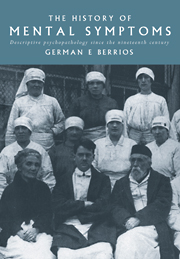Book contents
- Frontmatter
- Contents
- PREFACE
- ACKNOWLEDGEMENTS
- INTRODUCTION
- PART I The object of inquiry
- PART II Cognition and consciousness
- CHAPTER 3 Disorders of perception
- CHAPTER 4 Thought disorder
- CHAPTER 5 Delusions
- CHAPTER 6 Obsessions and compulsions
- CHAPTER 7 Mental Retardation
- CHAPTER 8 Cognitive impairment
- CHAPTER 9 Memory and its disorders
- CHAPTER 10 Consciousness and its disorders
- PART III Mood and emotions
- PART IV Volition and action
- PART V Miscellany
- REFERENCES
- NAME INDEX
- SUBJECT INDEX
CHAPTER 10 - Consciousness and its disorders
from PART II - Cognition and consciousness
Published online by Cambridge University Press: 08 January 2010
- Frontmatter
- Contents
- PREFACE
- ACKNOWLEDGEMENTS
- INTRODUCTION
- PART I The object of inquiry
- PART II Cognition and consciousness
- CHAPTER 3 Disorders of perception
- CHAPTER 4 Thought disorder
- CHAPTER 5 Delusions
- CHAPTER 6 Obsessions and compulsions
- CHAPTER 7 Mental Retardation
- CHAPTER 8 Cognitive impairment
- CHAPTER 9 Memory and its disorders
- CHAPTER 10 Consciousness and its disorders
- PART III Mood and emotions
- PART IV Volition and action
- PART V Miscellany
- REFERENCES
- NAME INDEX
- SUBJECT INDEX
Summary
The diaphanous nature of consciousness (as experienced by its owner) is more than matched by its opaqueness to analysis and description. And yet a descriptive psychopathology which did not include this concept would be difficult to imagine. Thus, during the nineteenth century, many ‘mental symptoms’ were defined in terms of introspective data from consciousness (e.g. hallucinations, depersonalization, dejd vu, etc.). The subjectivity of the madman became a private theatre where phantasms played dramas to which the psychiatrist had no direct access. All he could do was get the privileged seer to describe the experiences and then believe that the patient was telling the truth. It goes without saying that such belief is based on the assumptions that consciousness exists and that the patient's descriptive capacity has been spared by the disease.
But in clinical practice things are more complicated than that. Sensations, images, feelings and impulses, often odd or never experienced before, must be recognized and put into words by a person who is simultaneously bemused, confused, upset, terrified or who may actually be participating in the inner drama. Therefore, what the psychiatrist may get is a prosaic, analogical, or bizarre paraphrase. Based on training and imagination, the interviewer will try to name and classify those descriptions that sound familiar. But what about the many which do not? In current practice, and due to the control of ready-made glossaries, it is likely that such descriptions will be quietly ignored. This is a pity for these unnamed experiences are also markers of disease. In the past, when alienists felt freer to describe madness, patients were listened to: that was the manner in which current symptoms were born.
- Type
- Chapter
- Information
- The History of Mental SymptomsDescriptive Psychopathology since the Nineteenth Century, pp. 229 - 260Publisher: Cambridge University PressPrint publication year: 1996
- 2
- Cited by



